Observations of Near-Inertial Internal Waves over the Continental Slope in the Northeastern Black Sea
Abstract
:1. Introduction
2. Materials and Methods
3. Results
3.1. Observations of NIWs in Winter Conditions
3.2. Observations of NIWs in the Summer
3.3. Comparison of NIWs during Winter and Summer Observations
4. Discussion
5. Conclusions
Author Contributions
Funding
Institutional Review Board Statement
Informed Consent Statement
Data Availability Statement
Conflicts of Interest
References
- Alford, M.H.; Mackinnon, J.A.; Simmons, H.L.; Nash, J.D. Near-Inertial Internal Gravity Waves in the Ocean. Ann. Rev. Mar. Sci. 2016, 8, 95–123. [Google Scholar] [CrossRef] [PubMed]
- Konyaev, K.V.; Sabinin, K.D. Waves Inside the Ocean; Hydrometeoizdat: St. Petersburg, Russia, 1992. [Google Scholar]
- Pollard, R.T.; Millard, R.C. Comparison between observed and simulated wind-generated inertial oscillations. Deep. Res. 1970, 17, 813–821. [Google Scholar] [CrossRef]
- Garrett, C.; Munk, W. Space-time scales of internal waves: A progress report. J. Geophys. Res. 1975, 80, 291–297. [Google Scholar] [CrossRef]
- Fu, L.-L. Observations and models of inertial waves in the deep ocean. Rev. Geophys. 1981, 19, 141–170. [Google Scholar] [CrossRef]
- MacKinnon, J.A.; Gregg, M.C. Near-inertial waves on the New England shelf: The role of evolving stratification, turbulent dissipation, and bottom drag. J. Phys. Oceanogr. 2005, 35, 2408–2424. [Google Scholar] [CrossRef]
- Alford, M.H.; Whitmont, M. Seasonal and spatial variability of near-inertial kinetic energy from historical moored velocity records. J. Phys. Oceanogr. 2007, 37, 2022–2037. [Google Scholar] [CrossRef]
- Maksimova, E.V. A conceptual view on inertial internal waves in relation to the subinertial flow on the central west Florida shelf. Sci. Rep. 2018, 8, 15952. [Google Scholar] [CrossRef]
- Yang, B.; Hu, P.; Hou, Y. Variation and Episodes of Near-Inertial Internal Waves on the Continental Slope of the Southeastern East China Sea. J. Mar. Sci. Eng. 2021, 9, 916. [Google Scholar] [CrossRef]
- Van der Lee, E.M.; Umlauf, L. Internal wave mixing in the Baltic Sea: Near-inertial waves in the absence of tides. J. Geophys. Res. 2011, 116, C10016. [Google Scholar] [CrossRef]
- Lappe, C.; Umlauf, L. Efficient boundary mixing due to near-inertial waves in a nontidal basin Observations from the Baltic Sea. J. Geophys. Res. Ocean. 2016, 121, 8287–8304. [Google Scholar] [CrossRef]
- Senjyu, T. Observation of near-inertial internal waves in the abyssal Japan Sea. La Mer 2015, 53, 43–51. [Google Scholar]
- Senjyu, T.; Shin, H.-R. Flow intensification due to the superposition of near-inertial internal waves in the abyssal Yamato and Tsushima Basins of the Japan Sea (East Sea). J. Geophys. Res. Ocean. 2021, 126, e2020JC016647. [Google Scholar] [CrossRef]
- Klyuvitkin, A.; Ostrovskii, A.; Lisitzin, A.; Konovalov, S. The Energy Spectrum of the Current Velocity in the Deep Part of the Black Sea. Dokl. Earth Sci. 2019, 488, 1222–1226. [Google Scholar] [CrossRef]
- Khimchenko, E.; Ostrovskii, A.; Klyuvitkin, A.; Piterbarg, L. Seasonal Variability of Near-Inertial Internal Waves in the Deep Central Part of the Black Sea. J. Mar. Sci. Eng. 2022, 10, 557. [Google Scholar] [CrossRef]
- Yampolsky, A.D. Internal waves in the Black Sea as observed at a multi-day anchor station. Proc. IOAS USSR 1960, 39, 111–126. [Google Scholar]
- Morozov, A.N.; Mankovskaya, E.V.; Fedorov, S. Inertial Oscillations in the Northern Part of the Black Sea Based on the Field Observations. Fundam. Prikl. Gidrofiz. 2021, 14, 43–53. [Google Scholar] [CrossRef]
- Medvedev, I.P. Tides in the Black Sea: Observations and numerical modelling. Pure Appl. Geophys. 2018, 175, 1951–1969. [Google Scholar] [CrossRef]
- Garrett, C. What is the “Near-inertial” band and why is it different from the rest of the internal wave spectrum? J. Phys. Oceanogr. 2001, 31, 962–971. [Google Scholar] [CrossRef]
- Le Boyer, A.; Alford, M.H.; Pinkel, R.; Hennon, T.D.; Yang, Y.J.; Ko, D.; Nash, J. Frequency shift of near-inertial waves in the South China sea. J. Phys. Oceanogr. 2020, 50, 1121–1135. [Google Scholar] [CrossRef]
- Mori, K.; Matsuno, T.; Senjyu, T. Seasonal/spatial variations of the near-inertial oscillations in the deep water of the Japan Sea. J. Oceanogr. 2005, 61, 761–773. [Google Scholar] [CrossRef]
- Van Aken, H.M.; van Haren, H.; Maas, L.R.M. The high-resolution vertical structure of internal tides and near inertial waves, measured with an ADCP over the continental slope in the Bay of Biscay. Deep Sea Res. Part I Oceanogr. Res. Pap. 2007, 54, 533–556. [Google Scholar] [CrossRef]
- Serebryany, A.N.; Khimchenko, E.E. Strong Variability of sound velocity in the Black Sea Shelf Zone Caused by Inertial Internal Waves. Acoust. Phys. 2018, 64, 580–589. [Google Scholar] [CrossRef]
- Himchenko, E.E.; Serebrjanyj, A.N. Vnutrennie volny na kavkazskom i krymskom shel’fah Chernogo morja (po letne-osennim nabljudenijam 2011–2016 gg). Okeanol. Issled. 2018, 46, 69–87. [Google Scholar]
- Serebryany, A.; Khimchenko, E.; Zamshin, V.; Popov, O. Features of the Field of Internal Waves on the Abkhazian Shelf of the Black Sea according to Remote Sensing Data and In Situ Measurements. J. Mar. Sci. Eng. 2022, 10, 1342. [Google Scholar] [CrossRef]
- Bondur, V.G.; Sabinin, K.D.; Grebenuk, U.V. Characteristics of Inertial Oscillations Based on the Data of Experimental Measurements of Currents on the Russian Shelf of the Black Sea. Izv. Russ. Acad. Sci. Phys. Atmos. Ocean 2017, 53, 135–142. [Google Scholar] [CrossRef]
- Sabinin, K.D.; Korotaev, G.K. Inercionnye kolebanija v prisutstvii sdvigovogo techenija v okeane. Izv. Ross. Akad. Nauk. Fiz. Atmos. Okeana 2017, 53, 399–405. [Google Scholar]
- Serebryany, A.N.; Khimchenko, E.E. Internal Waves of Mode 2 in the Black Sea. Dokl. Earth Sci. 2019, 488, 1227–1230. [Google Scholar] [CrossRef]
- Ostrovskii, A.G.; Zatsepin, A.G. Intense ventilation of the Black Sea pycnocline due to vertical turbulent exchange in the Rim Current area. Deep Res. Part I Oceanogr. Res. Pap. 2016, 116, 1–13. [Google Scholar] [CrossRef]
- Ostrovskii, A.G.; Zatsepin, A.G.; Solovyev, V.A.; Soloviev, D.M. The short timescale variability of the oxygen inventory in the NE Black Sea slope water. Ocean Sci. 2018, 14, 1567–1579. [Google Scholar] [CrossRef]
- Gonella, J. A rotary-component method for analysing meteorological and oceanographic vector time series. Deep Res. Oceanogr. Abstr. 1972, 19, 833–846. [Google Scholar] [CrossRef]
- Mooers, C.N.K. A technique for the cross spectrum analysis of pairs of complex-valued time series, with emphasis on properties of polarized components and rotational invariants. Deep Res. Oceanogr. Abstr. 1973, 20, 1129–1141. [Google Scholar] [CrossRef]
- Leaman, K.D. The Vertical Propagation of Inertial Waves in the Ocean. Ph.D. Thesis, Massachusetts Institute of Technology, Cambridge, MA, USA, 1975. [Google Scholar]
- Gill, A.E. Atmosphere-Ocean Dynamics; Academic Press: Orlando, FL, USA, 1982. [Google Scholar]
- Blatov, A.S.; Bulgakov, N.P.; Ivanov, V.A.; Kosarev, A.N.; Tujilkin, V.S. Variability of Hydrophysical Fields in the Black Sea; Hydrometeoizdat: St. Petersburg, Russia, 1984. [Google Scholar]
- Ivanov, V.A.; Belokopytov, V.N. Oceanography of the Black Sea; Marine Hydrophysical Institute, NAS of Ukraine: Sevastopol, Ukraine, 2011. [Google Scholar]
- Morozov, A.N.; Mankovskaya, E.V. Modern Studies of Water Dynamics in the North-Western Part of Black Sea from LADCP Measurements. 2021. Available online: http://intercarto.msu.ru/jour/article.php?articleId=947 (accessed on 12 February 2024).
- Zatsepin, A.G.; Kremenetskii, V.V.; Stanichnyi, S.V.; Burdyugov, V.M. Basin Circulation and Mesoscale Dynamics of the Black Sea Affected by Wind. In Modern Dynamics of the Ocean and Atmosphere; Triada: Moscow, Russia, 2010; pp. 347–368. [Google Scholar]
- Ciliberti, S.A.; Jansen, E.; Coppini, G.; Peneva, E.; Azevedo, D.; Causio, S.; Stefanizzi, L.; Creti’, S.; Lecci, R.; Lima, L.; et al. The Black Sea Physics Analysis and Forecasting System within the Framework of the Copernicus Marine Service. J. Mar. Sci. Eng. 2022, 10, 48. [Google Scholar] [CrossRef]
- Kunze, E. Near-inertial wave propagation in geostrophic shear. J. Phys. Oceanogr. 1985, 15, 544–565. [Google Scholar] [CrossRef]
- Mooers, C.N. Several effects of a baroclinic current on the cross-stream propagation of inertial-internal waves. Geophys. Astrophys. Fluid Dyn. 1975, 6, 245–275. [Google Scholar] [CrossRef]
- Jaimes, B.; Shay, L. Near-Inertial Wave Wake of Hurricanes Katrina and Rita over Mesoscale Oceanic Eddies. J. Phys. Oceanogr. 2010, 40, 1320–1337. [Google Scholar] [CrossRef]
- Vlasenko, V.I.; Ivanov, V.A.; Lisichenok, A.D.; Krasin, I.G. Generacija intensivnyh korotkoperiodnyh vnutrennih voln vo frontal’noj zone pribrezhnogo apvel-linga. Morskoj Gidrofiz. Zhurnal. 1997, 3, 3–16. [Google Scholar]
- Vlasenko, V.I.; Ivanov, V.A.; Stashchuk, N.M. Generation of near-inertial motions during upwelling. Phys. Oceanogr. 1996, 36, 43–51. [Google Scholar]
- Gill, A.E. On the Behavior of Internal Waves in the Wakes of Storms. J. Phys. Oceanogr. 1984, 14, 1129–1151. [Google Scholar] [CrossRef]
- Kubryakov, A.A.; Stanichny, S.V.; Zatsepin, A.G.; Kremenetskiy, V.V. Long-term variations of the Black Sea dynamics and their impact on the marine ecosystem. J. Mar. Syst. 2016, 163, 80–94. [Google Scholar] [CrossRef]
- Zatsepin, A.G.; Ginzburg, A.I.; Kostianoy, A.G.; Kremenetskiy, V.V.; Krivosheya, V.G.; Stanichny, S.V.; Poulain, P.M. Observations of Black Sea mesoscale eddies and associated horizontal mixing. J. Geophys. Res. Ocean. 2003, 108, 1–27. [Google Scholar] [CrossRef]
- Kubryakov, A.A.; Stanichny, S.V. Seasonal and interannual variability of the Black Sea eddies and its dependence on characteristics of the large-scale circulation. Deep Res. Part I Oceanogr. Res. Pap. 2015, 97, 80–91. [Google Scholar] [CrossRef]
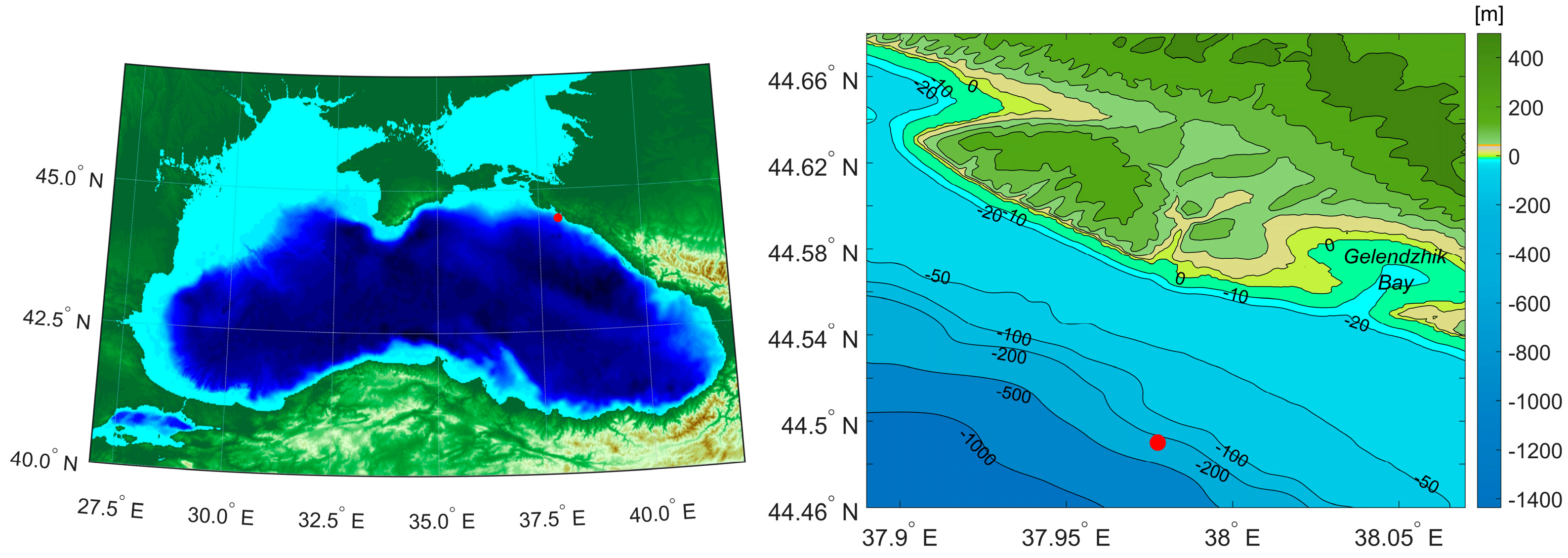
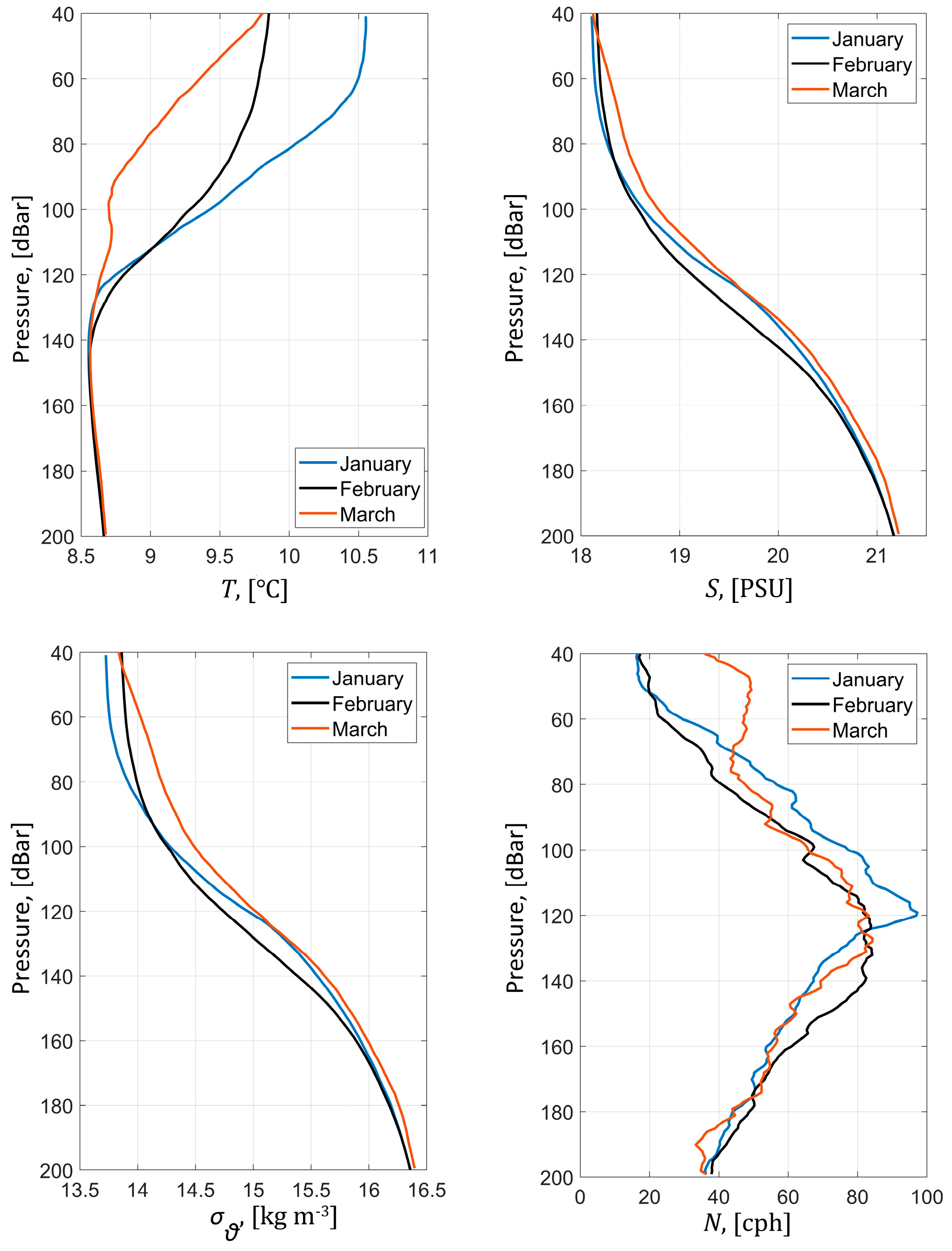

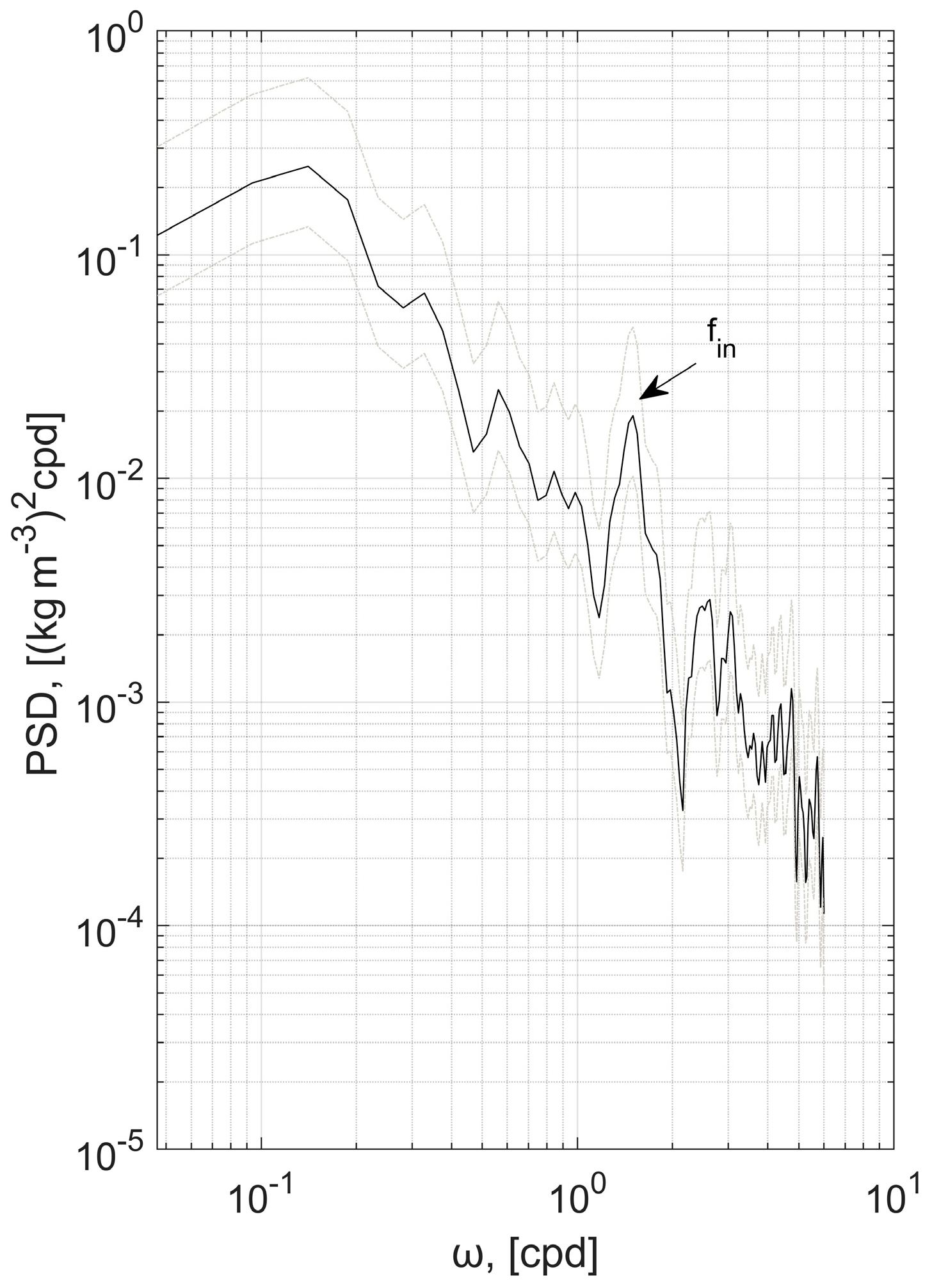
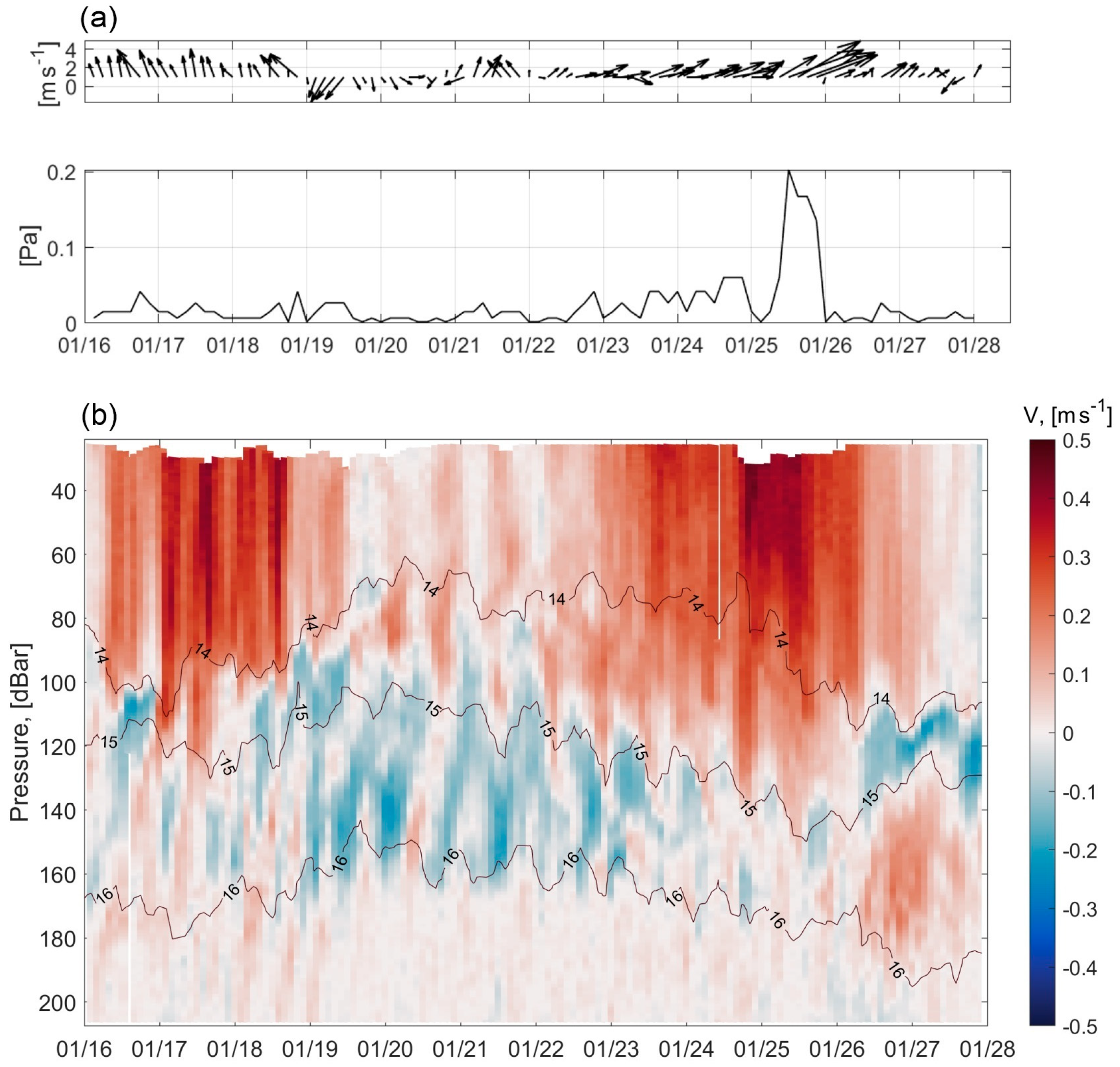



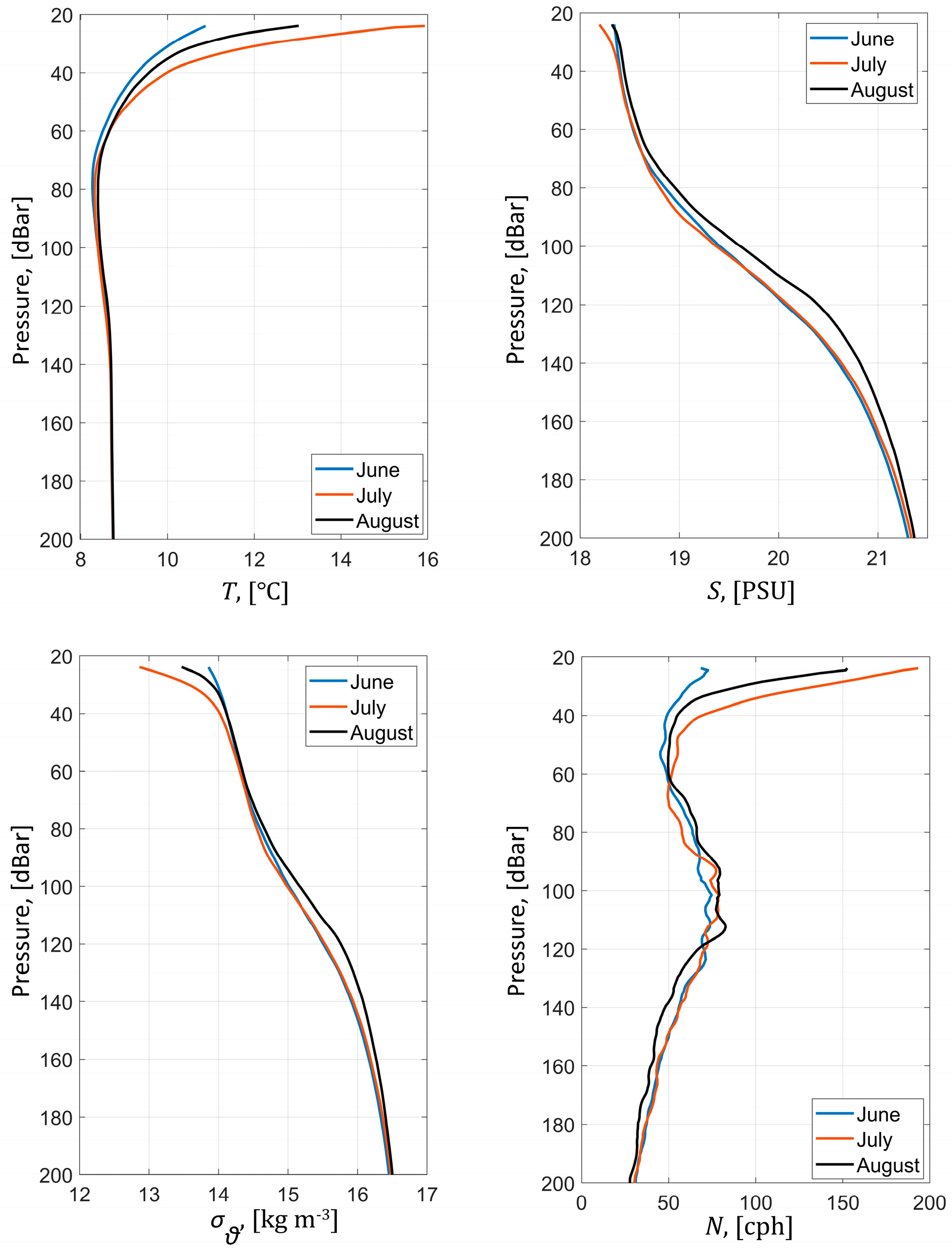
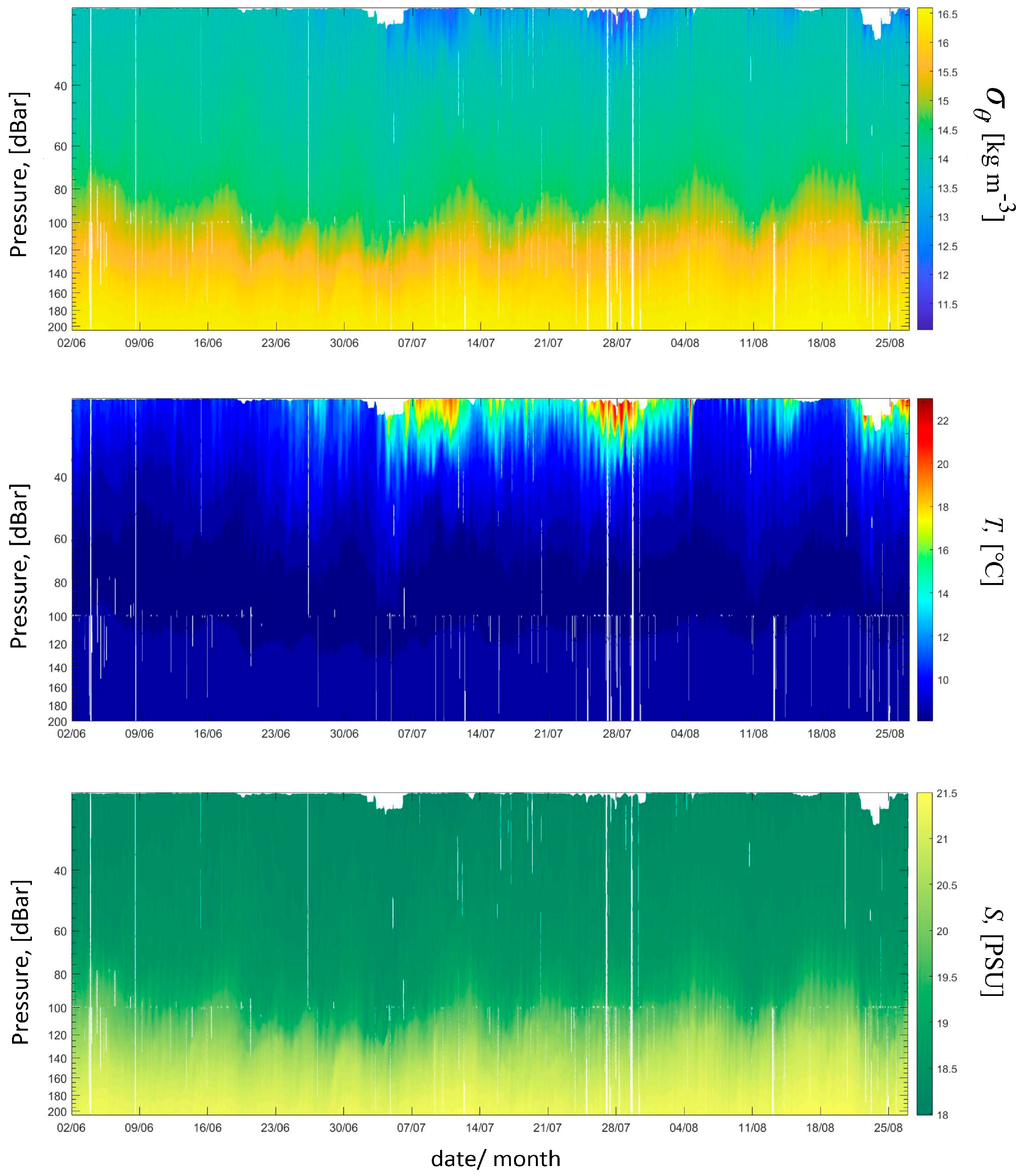





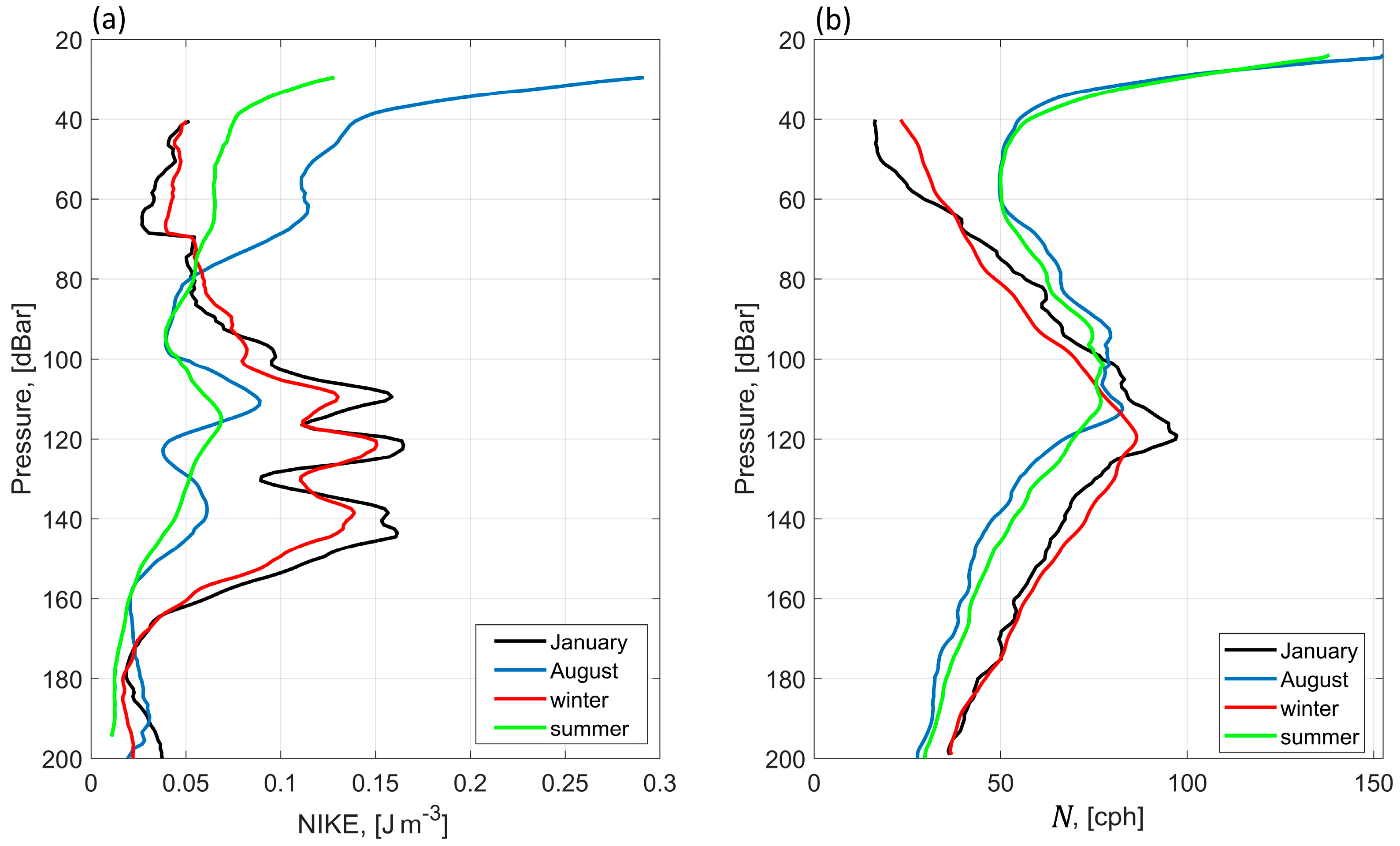
Disclaimer/Publisher’s Note: The statements, opinions and data contained in all publications are solely those of the individual author(s) and contributor(s) and not of MDPI and/or the editor(s). MDPI and/or the editor(s) disclaim responsibility for any injury to people or property resulting from any ideas, methods, instructions or products referred to in the content. |
© 2024 by the authors. Licensee MDPI, Basel, Switzerland. This article is an open access article distributed under the terms and conditions of the Creative Commons Attribution (CC BY) license (https://creativecommons.org/licenses/by/4.0/).
Share and Cite
Khimchenko, E.; Ostrovskii, A. Observations of Near-Inertial Internal Waves over the Continental Slope in the Northeastern Black Sea. J. Mar. Sci. Eng. 2024, 12, 507. https://doi.org/10.3390/jmse12030507
Khimchenko E, Ostrovskii A. Observations of Near-Inertial Internal Waves over the Continental Slope in the Northeastern Black Sea. Journal of Marine Science and Engineering. 2024; 12(3):507. https://doi.org/10.3390/jmse12030507
Chicago/Turabian StyleKhimchenko, Elizaveta, and Alexander Ostrovskii. 2024. "Observations of Near-Inertial Internal Waves over the Continental Slope in the Northeastern Black Sea" Journal of Marine Science and Engineering 12, no. 3: 507. https://doi.org/10.3390/jmse12030507




